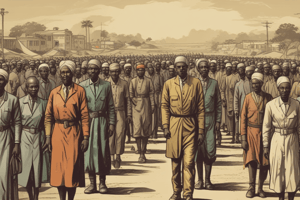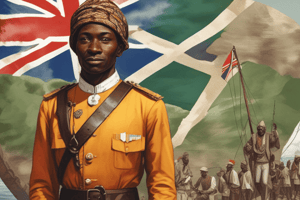Podcast
Questions and Answers
What was the primary outcome of the South Africa Act regarding the political structure of the Union of South Africa?
What was the primary outcome of the South Africa Act regarding the political structure of the Union of South Africa?
The South Africa Act resulted in a unitarystate that granted limited parliamentary democracy to the white minority while ignoring the political aspirations of the indigenous majority.
How did the Union Constitution address the voting rights of black citizens in the Cape compared to the northern provinces?
How did the Union Constitution address the voting rights of black citizens in the Cape compared to the northern provinces?
The Union Constitution allowed the Cape to retain limited voting rights for black citizens, while northern provinces excluded all black South Africans from the electoral process.
What role did the Governor-General in Council play in the administration of native affairs as per the Union Constitution?
What role did the Governor-General in Council play in the administration of native affairs as per the Union Constitution?
The Governor-General in Council was vested with control and administration of native affairs, holding special powers in relation to native administration.
In what way did the Union Constitution reflect colonial views on African society?
In what way did the Union Constitution reflect colonial views on African society?
What was the implication of having a Westminster-style parliamentary system within the context of South Africa's Union Constitution?
What was the implication of having a Westminster-style parliamentary system within the context of South Africa's Union Constitution?
Flashcards are hidden until you start studying
Study Notes
The Union of South Africa (1910)
- The Union of South Africa was formed in 1910, uniting the four settler colonies (Cape, Natal, Orange Free State, and Transvaal ) and various indigenous groups into a single unitary state.
- The Union Constitution granted limited parliamentary democracy to the white minority, excluding the black majority from participation in the electoral process.
- The Constitution established a bifurcated state, with the white minority holding political power while the black majority was subject to autocratic administrative rule.
- The Union Constitution retained limited voting rights for black citizens in the Cape, but this did not change the fundamentally racist and paternalistic nature of the Constitution.
- The Constitution placed "native affairs" under the control of the Governor-General in Council, granting the Governor-General "all special powers in regard to native administration".
- The Union Constitution laid the groundwork for the later implementation of apartheid, which emerged in 1949 as a formal system of racial segregation and discrimination.
- The Union Constitution can be seen as a continuation of colonial structures, further marginalizing indigenous South Africans, their governance structures, and customary law.
The 1996 South African Constitution’s Aims and Challenges
- The 1996 South African Constitution aims to transform the South African society from one characterized by racial inequality and discrimination to a more democratic, egalitarian, and inclusive society.
- The Constitution includes provisions for the recognition and preservation of indigenous governance structures.
- The Constitution is seen as a tool for safeguarding the legitimacy of constitutional review and interpretation.
- The Constitution's transformative potential is evident in the South African Constitutional Court's judgments, which reinforce the need for societal change.
- The Constitution has faced challenges in achieving these aims due to the political and economic realities in South Africa.
- The ANC's dominance in the political system has raised concerns about the effectiveness of the Constitution in promoting a truly multi-party democracy.
- The Constitution's ability to effectively achieve its transformative goals has been questioned given the entrenched inequalities and the persistence of historical injustices.
- The Constitution needs to be interpreted in the context of South Africa's complex history, social dynamics, and lingering effects of colonialism and apartheid, which continue to shape the country's political and economic landscape.
Studying That Suits You
Use AI to generate personalized quizzes and flashcards to suit your learning preferences.




